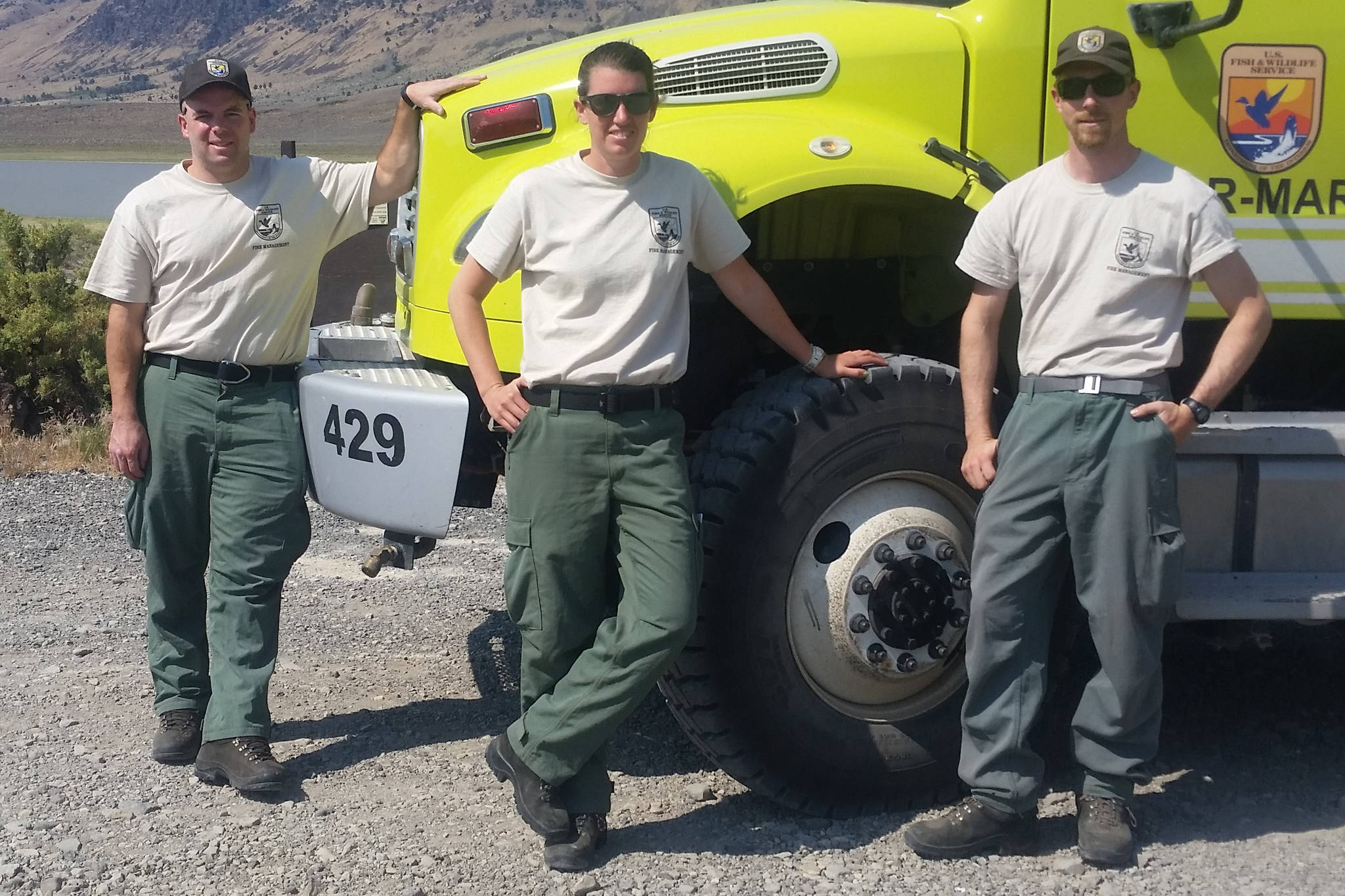Editor’s note: This article originally appeared in the Sept. 14, 2018, edition of the Clarion.
This past August, I had the unique experience of traveling to Malheur National Wildlife Refuge in Princeton, Oregon. While most people visiting Malheur come to see migratory birds at Lake Malheur and its associated wetlands, I came to patrol its vast landscapes while on-call to respond to wildfires.
I traveled with two others from the Kenai National Wildlife Refuge — my engine captain, Will, and another qualified firefighter, Christa. We were dispatched to four fires altogether, with three of the four calls occurring just before or after dark.
Nearly 2,000 miles separate the Kenai refuge from the Malheur refuge, so it was somewhat surprising to find similarities in their geography. Both the Kenai and Malheur were shaped by glaciers.
When we drove on the Steens Loop Road on Malheur, I was amazed by how much this massive fault-block mountain reminded me of hiking the alpine zones of the Kenai. The subalpine grassland was expansive and the valleys below stretched out for hundreds of miles.
It generated a feeling of grandness that I only feel when exploring wilderness – the Steens Mountain Wilderness Area is over 170,000 acres.
But it was also very different than the Kenai. Aside from being much hotter and dryer, the Steens is home to the wild Kiger Mustangs, which are celebrated as very beautiful horses. This is much different than the wild moose that run amok on the Kenai, with their goofy gates and droopy gazes.
The main water source for Lake Malheur is the Donner und Blitzen River, which starts as an intermittent stream in Steens Mountain and finds its way through glaciated valleys and canyons as it snakes through marshes in the high desert. The river does not pass through a single town.
I looked up why the river was given a German name, meaning “thunder and lightning.” In 1864, a unit of the 1st Oregon Calvary was sent to protect settlements from the Paiute tribe. The unit was led across the river during a storm by Captain George B. Curry, who named the river and happened to be from Indiana.
So I didn’t find out why it has a German name, but sometimes mystery is more powerful than truth. Malheur gets a lot of lightning, most of which is dry lightning. This, combined with persistent hot and dry weather, is the reason for severe fire danger.
It was 19:30 – military time for 7:30pm. We had 30 minutes remaining in our shift and we were excited for dinner and early bed. Just then, our sister engine E-624 sent a crew member, Phillip, over to tell us that we had a fire.
It was off district and all resources there were exhausted (they were probably tired, too) but this means we were needed to respond. We grabbed what prepared food we could find and hit the road.
At 21:30, we arrived on scene. Local volunteers had been working the fire with a dozer, several ATVs and a Unimog. The incident commander at that time was helitacked from Vale, Oregon. He was without transportation because he was dropped off with a three-person crew via helicopter to help get a handle on the 80-acre blaze.
We reconfigured our radios to the new district’s frequencies and began moving to where the fire activity had unexpectedly increased since our arrival. Travel in our truck along the dozer line was slow. We staffed a type-four engine, which requires a commercial driver’s license and carries 750 gallons of water. I had to remove rocks on several occasions that were lodged between the rear dual tires.
As we got around the fire, it was traveling toward us from the west with a 5 mph wind behind it. It was hard to see how close it was to us because we were a couple hundred feet away from a box canyon rim, with the fire below. We decided to get a closer look on foot to check the fire’s intensity. It was moving slowly but steadily up the slope toward the lip of the rim we stood on.
We returned to the engine, fired up the pump and wetted down the area surrounding the dozer. The dozer had broken down on the wrong side of the line, so our priority was to protect it. Once the fire burned over the lip of the canyon rim, the winds increased and fire ate away at sage and cheat grass until embers were flying across the line. When the smoke became dense enough, it felt like bear spray or wasabi, with eyes watering and noses running uncontrollably.
We continued to protect the dozer and repositioned to wet down the line where fire activity was most extreme. Only a few minutes had seemingly passed, but we repositioned the engine on a steep and narrow dozer line several times before the fire quieted down.
At 01:30, the incident commander radioed that if we thought the fire was going to be secure for the night, we should try to get some sleep. But the dozer was still inoperable because one of its rods had come off the arm that holds the blade. We attempted to assist with our pneumatic jack and shovels for the next hour without success.
Before crawling into our sleeping bags, we relocated to a more solid black part of the fire – an area of the fire that had burned earlier and is not likely to burn again. We looked up at the stars above and saw lightning in the distance.
Scott Johnson is the trail crew leader at Kenai National Wildlife Refuge who has also worked wildland fires as collateral duty for the past nine years. His favorite season is winter, where he explores the Kenai Peninsula’s backcountry while skiing gnarly lines. Find more Refuge Notebook articles (1999-present) at https://www.fws.gov/Refuge/Kenai/community/Refuge_notebook.html.

